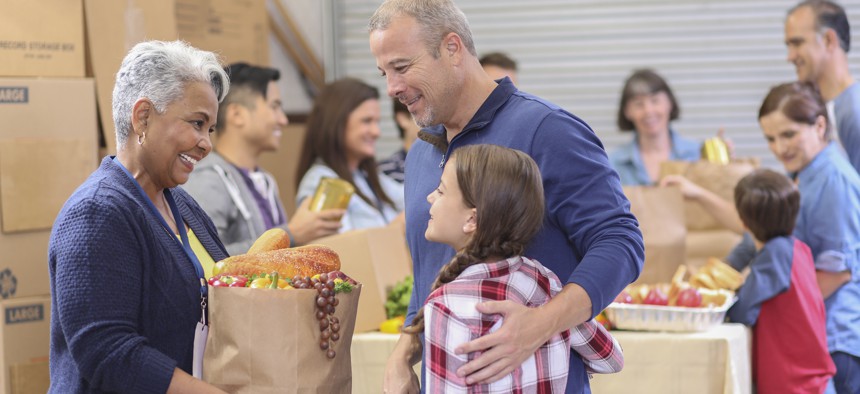As Food Banks Struggle to Feed More Families at Thanksgiving, Localities Step Up to Help

iStock.com/fstop123
Food shortages and soaring prices have hampered many charities' ability to collect and buy enough items. Municipal governments are investing new federal funds to boost these efforts.
As the holidays approach, many food bank officials worry they won’t have enough turkey, stuffing and cranberry sauce for Thanksgiving and Christmas for a growing number of food-insecure families. But in some areas, local governments are filling the gaps.
“Food banks have seen a large increase in demand with respect to Covid, and food prices have obviously risen due to supply chain issues,” said Rachel Mackey, associate legislative director for human services and education at the National Association of Counties. "A lot of counties were already in the business of doing things in the holiday food drives and food distribution efforts, and those efforts are ongoing and amped up, particularly post Covid."
The food shortage in the U.S. is partially being caused by supply chain issues, low inventory and labor shortages. In addition, prices have increased while people, businesses and industries are struggling to recover from the Covid-19 pandemic.
Earlier this month, the U.S. Bureau of Labor Statistics announced that the consumer price index rose 6.2% during the past year—the largest increase since December 1990. According to the bureau, the consumer price index includes products ranging from rent, health care, groceries and gas.
Food prices rose 5.3% in the last year and about 1% in the last month. Meat, poultry, fish and eggs collectively rose 1.7% in September and 11.9% year over year, according to the bureau.
Food-insecure people are being hit particularly hard by this crisis. Food banks across the country are serving 55% more people than before the pandemic, according to Feeding America. The number of people relying on food banks and other charities was intensified by the pandemic, and food banks are now accustomed to the increased number of people served, Feeding America says.
Meanwhile, supply chain disruptions, lower inventory and labor shortages have all contributed to increased costs for charities that tens of millions of people in the U.S. rely on. Donated food has also become more expensive to move due to rising transportation costs.
"We always urge additional resources from our federal partners to help us fill in the gaps because it is difficult to meet the increased demand when our resources don't always receive the same uptick," said Makey. "But, many counties are investing new federal dollars in food and security initiatives and other programs to help strengthen the systems that get people food."
El Paso County in Colorado is on locality providing food for its community. Volunteers and organizers came together for “Thanksfest 2021″ to give more than 300 low-income families items for their Thanksgiving dinner, according to KKTV.
“We’re not just handing turkeys out. I mean they have the whole thing. So it’s the turkeys, the pan, roasting bags, milk, marshmallows, yams, the beans, everything. We want them to be able to have the whole thing to cook in,” event organizer Vaughn Littrell told KKTV.
This year, more than $30,000 was raised through donations and the CPCD head start program, and next year organizers hope to expand the program to more than 500 people in the county, according to KKTV.
As for nonprofits, the Alameda County Community Food Bank in Oakland, California is spending an extra $60,000 a month on food. Combined with increased demand, it is now shelling out $1 million a month to distribute 4.5 million pounds of food, Michael Altfest, the Oakland food bank’s director of community engagement, told the Associated Press.
“It’s going to be an expensive Thanksgiving, turkey is not going to cost like the way it was," Martha Hasal, program coordinator at Bay Area American Indian Council, told AP. “And they’re not giving out turkey. So thank God they’re giving out the chicken.”
Local nonprofits in Mclean County, Illinois partnered up to provide families with food for Thanksgiving, according to Week.com.
Midwest Food Bank, Home Sweet Home Ministries, Thrivent Financial and others helped hand out 2,500 boxes of food filled with stuffing, rolls and turkey.
The CEO of Home Sweet Home Ministries, Matt Burgess, told Week.com between 8,000 to 10,000 people can enjoy a Thanksgiving meal thanks to the community pitching in to help.
Burgess said coming together to help others in need shows the true meaning of Thanksgiving.
“Big smiles and expressions of gratitude, even when people have masks on, you can see their eyes that they’re just so thankful,” Burgess told Week.com.
Andre Claudio is the assistant editor for Route Fifty.
NEXT STORY: More Than Two Dozen States in Limbo on Vaccine Mandate for Government Workers





